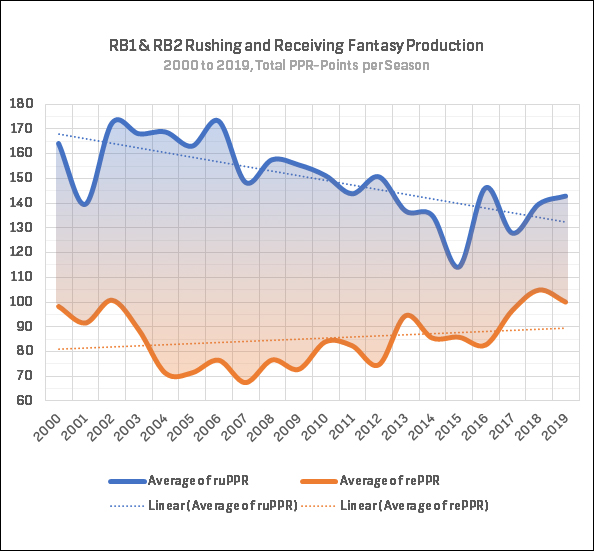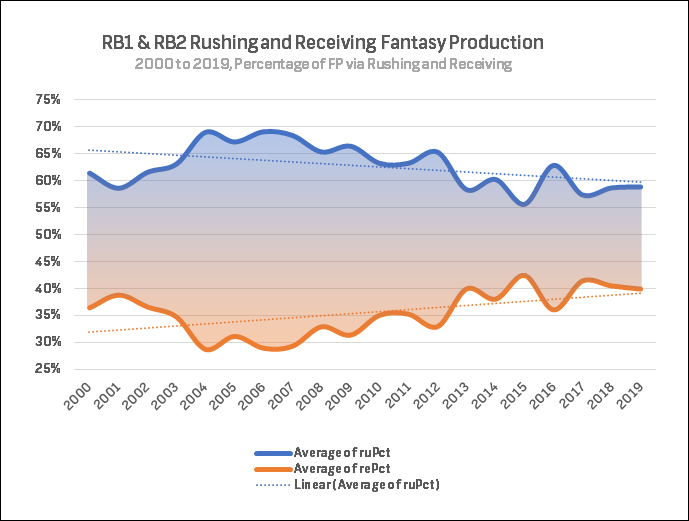As the 2019 summer kept going we all had two things in our minds with regard to September's fantasy drafts and both of them were related to running backs: Where in the world are Ezekiel Elliott and Melvin Gordon and when will they be back? It made sense back then (and it still does now, don't get me wrong), given their incredible 2018 seasons. Elliott finished that year with 329 PPR-points (RB5) and Gordon did so at 276 good for RB8. At 23 and 25 years of age respectively, drafting those two studs in any of the first slots in 2019 would be advisable at the very least, but both of them were holding out at the time, lowering their upside and bumping up the risks.
Elliott was back in Dallas in time to start the season, but Gordon missed the first four games entirely. While Elliott's situation didn't call for the use of a backup/handcuff in Dallas, Gordon's second-fiddle Austin Ekeler took on the leading role at the start of the season and by the end of the year, he was the RB4 of 2019 with 309 fantasy points, fewer than six behind second-best Aaron Jones (315).
Both Gordon in 2018 and Ekeler in 2019 (and any other running back in any season) performed duties as rushers and receivers during the year. Gordon got to his 276 fantasy points by dividing them into a 55% rushing and 45% receiving split. Ekeler's 309 points went to him via 23% rushing production and 77% receiving fantasy points. The difference is staggering, and Ekeler's 2019 season is an outlier in the history of fantasy football, but it serves to make the point of why do-it-all rushers are more important than ever these days. Let's try and find how those RBs are gaining historical importance these days.
Featured Promo: Get any full-season NFL Premium Pass for 50% off and win big in 2022. Exclusive access to our Premium articles, 15 lineup tools, new Team Sync platform, Lineup Optimizer, Premium DFS tools and cheat sheets, and much more! Sign Up Now!
The Gap Between Pure Runners and Pass-Catching RBs is Narrower Than Ever
The information I used for the introductory example comes from a dataset that goes back to the 2000 season. It contains 3,246 RB seasons in which those players performed in at least one game each in the given year.
In order to analyze how the league has evolved at the running position in terms of rushing/receiving fantasy production, I divided each rusher's fantasy points into "rushing points" and "receiving points". Given that I'm working with data from PPR-format leagues I named those ruPPR and rePPR, with PPR or FP being the total fantasy points on the season and PPR/G or FP/G the fantasy points per game.
As there are multiple RB seasons that really amounted to nothing, I limited my population to the top-24 running backs of each season, which is to say only the RB1/RB2 if we consider each tier is made of 12 players (the average amount of teams in a standard fantasy league). That gave me the best pair of starting running backs from each season (RB1 and RB2). Here is where those players' fantasy points have come from yearly since 2000:

If that plot was a cave and you had to walk through it from left to right, you'd notice two things:
- After descending the 2002 peak you will find yourself mostly going up and up and up almost without exception.
- You'll steadily see the roof become closer to you with each step, to the point where around the end of the cave you'd have reached the shortest of gaps between that roof and the floor.
Or, translated to fantasy football:
- The average top-24 rushers are getting more and more points from their receiving stats and prowess.
- The average top-24 rushers are getting fewer and fewer points from their rushing stats and prowess.
This doesn't mean running backs are getting worse at fantasy football. While they are not as surefire as their early 2000s counterparts, the top rushers from 2018 and 2019 had the two-highest total fantasy points since all the way back in 2006, and the trend has also been climbing upward from 2016 (included) on. What rushers are getting better at is catching the ball and performing all kinds of tasks on the field to get the most possible fantasy points they can.
Fantasy Implications
While the study above is representative and illustrates the point I'm making, it has a flaw in that we never know where fantasy points truly come from, or how many points would be earned by players at any position. The evolution of football has skewed stats to favor passers/wideouts and reduced the impact of the running game. That alone explains the decrease in RB fantasy points, although at the top of the leaderboards changes aren't that great.
Something very simple we can do to actually check how players are doing at the position in terms of rushing and receiving is looking at the percentages of points they're getting each way, as I did in the introductory Gordon/Ekeler example. Knowing the total fantasy points scored by each player we can easily calculate how many of those came via rushing and how many came via receiving, and finally, calculate the percentage they amounted to.
Here are the same top-24 players from each season and the percentage of their points that came via rushing/receiving since 2000:

The trend should be much clearer now with the cave becoming even more suffocating in its final stretch that it was during our first run, right? That, again, is because rushers are slowly but surely becoming more do-it-all players rather than just pure runners, and that is also showing at the top of the yearly fantasy leaderboards.
What once was an all-time (in fantasy terms) difference favoring rushing at 40% of over receiving (in the span from 2004 to 2007) has been getting narrower and narrower since 2015 with the exception of 2016 (the main reason being LeGarrette Blount, whose ridiculous 95%/5% ruPPR/rePPR split skewed the full 24-man field average a bit).
Just so the evolution is clearer, here is another plot including the number of RB1/RB2 rushers with at least 50% of their points coming through the air instead of on the ground that made the top-24 each of the past 20 seasons:

Not only is the trend going upward, but 2019 marked the highest number of rushers (along with those found in the 2001 and 2014 seasons) who relied more on receiving than rushing to get the bulk of their fantasy points and still finish as top-24 performers on the year. During the first 13 years of the decade just once (2001) did we see at least five rushers qualify, while in the last seven seasons that has happened in all but two years (2016 and 2017).
The 2019 peak (seven players) mean that 29% of the top-24 rushers of the year were better fantasy receivers than rushers while being labeled RBs. The average in the 20-year span is of a 16% per season (78 total players distributed in 20 years, considering RB1/RB2). That is almost double the average this past season than in the past twenty years, and it feels like the trend is only getting started.
How to Use This to Your Advantage
One last thing for those trying the get advantage of the do-it-all rushers come 2020 draft season: there is a negative correlation between rePPR and ADP. Translated: the more points a running back gets through receiving compared to rushing, the "cheaper" he usually is.
This shouldn't come as a surprise. Pure, surefire-rushers are those most coveted at the top of draft boards. There are 3,246 RB seasons registered since the year 2000. Of those, 76 represent players that racked up at least 200 ruPPR and their ADPs averaged a 24.6 pick in drafts. If we only consider the 65 players with ADPs under 48 (fourth round or higher picks), the average ADP decreases to 15, a high-end RB2 and virtual low-end RB1.
Obviously, there have not been that many 200-point rePPR rushers in the last 20 years (only nine). But if we lower our threshold to 150-plus rePPR on the season we find 40 since 2000. Those 40 players' ADP average is 58.8, more than double that of the first group of "super-rushers", yet all but three of them finished their seasons as top-24 (aka RB2) at the very least -- the other three finished 27th, 27th, and 28th, though.
This should clear any internal debate you have about rushing vs. receiving tailbacks. Other than those picked within the first three-to-five picks in the first round, you're better off drafting do-it-all running backs. In a serpentine draft, this could be an intelligent "average strategy" with the data at hand:
- Picks 1 through 4: Surefire rushers, no matter their receiving prowess
- Picks 5 through 8: Surefire receivers
- Picks 9 through 16: Best do-it-all running backs (not focusing on pure rushing stats), top-tier receivers
More Fantasy Football Analysis
 RADIO
RADIO






















